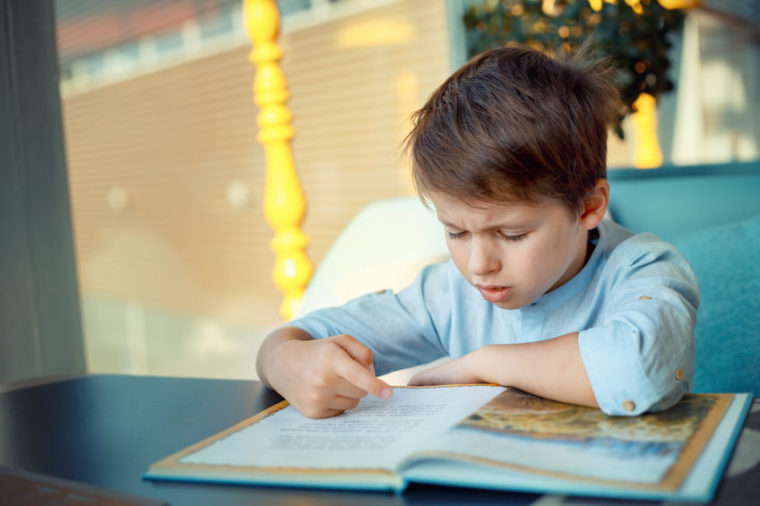Some mechanical visual skills are related to reading. Sharpening your child’s sense of sight and the brain-building that goes with it is serious work.

What are Basic Mechanical Skills of the Visual System?
Visual mechanical skills have to do with the muscles that control the eyes. There are 6 muscles attached to each eyeball and the socket, which control all the movement and positioning of the eye.
Three mechanical visual skills are usually associated with poor reading. They are eye movements, eye teaming, and focusing.
Eye Movements
Eye movement control (tracking) is the ability to move both eyes together to focus on an image, or path. Of the four basic types of eye movements, two are generally associated with reading – saccades and pursuits, also known as smooth following movements.
Saccades are rapid movements of the eyes whereby we change the point of fixation from one target to the next, looking directly and steadily at each.
Pursuits are slower tracking movements of the eyes that are under a person’s voluntary control as he follows a moving visual target.
Most eye movement is carried out without awareness and allow easy shifting of the eyes along the line of print in a book, then a rapid and accurate return to the next line. Children who cannot make accurate eye movements often skip lines and words when reading.
Eye Teaming
Eye teaming, also known as binocular vision, refers to the ability to use both eyes in a precise and coordinated manner, that is, as a team. This is what makes vision comfortable and allows your eyes to turn in towards the nose and focus on a book or computer screen. If both of your child’s eyes do not work in a precise and coordinated manner, he may experience double vision.
Most children with double vision do not report it. They assume that’s how everyone sees. When reading, they frequently lose their place, words appear to move on the page, and they may complain of having headaches. These children also have poor handwriting, and sometimes, poor depth perception.
Focusing
This is the ability of the eye to look from one distance to another whether near or far or sustained near tasks, and maintain accurate clarity. It is important when the child has to look from his desk to the board or read for prolonged periods.
Children with focusing deficits complain of blurred vision, fatigue or headaches while reading, and fuzzy vision at a distance after reading.
How Can You Help Your Child Develop Good Eyesight?
- Place toys within the focus of your baby’s eyes.
- Encourage your baby to crawl.
- Get him sturdy cardboard or cloth books with simple, clear drawings or photographs of everyday objects, people, or animals.
- Give your child toys that encourage visual development, e.g. building blocks, puzzles, stringing beads.
- Talk to your child as you move around the room to encourage his eyes to follow you.
The 3 Secrets
- When your child’s eyes are tracking efficiently, they will move accurately, smoothly, and quickly from place to place scanning the visual environment.
- Normal eye teaming allows him to produce clear, sustained, comfortable single vision.
- If your child can accurately make adjustments to focus, every time he looks from one place to another, his focusing muscles are functioning competently.
If he has trouble in one or more of the above-mentioned skills, it is important to determine the cause of his deficits and get treatment for him as soon as possible.
Prominent researchers from Boston’s Children Hospital and Harvard Medical found that eye teaming, eye focusing and eye tracking deficits occur in 75% of children who struggle with reading. Fortunately, these skills can be treated and strengthened with vision therapy.
Most children with visually based reading problems are overlooked because they pass the visual acuity test (20/20 vision). Consequently, further testing is not usually suggested. As noted in a previous article, it is a parent’s responsibility to carefully observe their children and ensure they get comprehensive vision testing from a developmental optometrist.
What type of vision problem have you or your child experienced?

I never thought of how important play is in a child’s developement. Great information.
Thank you. Play is a child’s work.
My nephew had a lazy eye and he had to wear glasses for a while. I’m just nearsighted so I have to wear corrective lenses for that. When I was a kid, I did have some problem tracking the written word but that problem seems to have resolved itself. I no longer get the sensation of jumping off a cliff when I start to read lots of information on a piece of payer. I still, however, have difficulty with forms and anything that looks like a standardized test with fill in the bubble type thingie.
I believe that every family has a “vision” story. When I was a child, it was just the 20/20 visual acuity test that was given by the eye doctor. Thank God, there are so many ways to help children today. I’m glad some of your visual challenges were resolved. Thanks for your continued support, Alice.
Hi Florence
Your teaching about tracking reminds me of a recent discovery I made while watching the ears of a horse rotate from the side to the front.
I’m sure you found that quite fascinating. 😁 I’ve seen some remarkable eye movements from children whom I’ve tested.